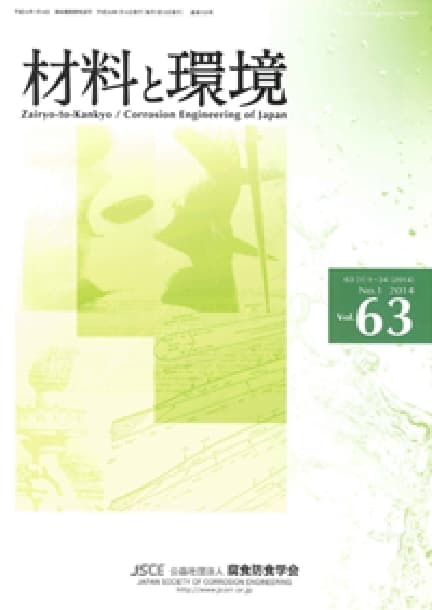材料と環境 Vol. 66 (2017), No. 10
Backnumber
-
Vol. 74 (2025)
-
Vol. 73 (2024)
-
Vol. 72 (2023)
-
Vol. 71 (2022)
-
Vol. 70 (2021)
-
Vol. 69 (2020)
-
Vol. 68 (2019)
-
Vol. 67 (2018)
-
Vol. 66 (2017)
-
Vol. 65 (2016)
-
Vol. 64 (2015)
-
Vol. 63 (2014)
-
Vol. 62 (2013)
-
Vol. 61 (2012)
-
Vol. 60 (2011)
-
Vol. 59 (2010)
-
Vol. 58 (2009)
-
Vol. 57 (2008)
-
Vol. 56 (2007)
-
Vol. 55 (2006)
-
Vol. 54 (2005)
-
Vol. 53 (2004)
-
Vol. 52 (2003)
-
Vol. 51 (2002)
-
Vol. 50 (2001)
-
Vol. 49 (2000)
-
Vol. 48 (1999)
-
Vol. 47 (1998)
-
Vol. 46 (1997)
-
Vol. 45 (1996)
-
Vol. 44 (1995)
-
Vol. 43 (1994)
-
Vol. 42 (1993)
-
Vol. 41 (1992)
-
Vol. 40 (1991)
キーワードランキング
18 Dec. (Last 30 Days)
材料と環境 Vol. 66 (2017), No. 10
Ⅰ.腐食の電気化学基礎
藤本 慎司
pp. 317-325
DOI:
10.3323/jcorr.66.317抄録
The definition and concept of electrode potential, equilibrium potential are simply explained on the basis of electrochemistry, considering not only thermodynamics but also electron energy.The potential-pH diagram, which is derived from electrochemical and other equilibrium, is also introduced as the corrosion map which provides an over view of corrosion susceptibility of various metals.
温水銅配管の孔食に及ぼす酸化物および各種イオンの影響
山中 秀文, 藤本 貴裕, 永井 智之, 野中 英正
pp. 328-334
DOI:
10.3323/jcorr.66.328抄録
Investigation to clarify the influence of various kinds of oxide deposit and anions (chloride ion, sulfate ion, and bicarbonate ion) in hot water on pitting corrosion of copper tubes was carried out. Anodic polarization and potentiostatic polarization measurements at critical pitting potential of 150 mV (SCE) using copper tube specimen with various kinds of oxide artificially deposited were made. It was found that pitting corrosion rate of the specimen was accelerated by artificial deposit of oxide and changed depending on kinds of oxide. It was also found that the anodic current in potensiostatic 1000 hour polarization was composed mainly of film formation current at the beginning of the polarization and was composed mainly of pitting corrosion current in the last stage of the polarization. In the synthetic solutions of various concentrations of chloride ion, sulfate ion and bicarbonate ion, potentiostatic polarization measurements of the specimen with CuO deposited were made. As a result, it was clearly shown that chloride ion had a more significant influence on pitting corrosion current of copper compared to sulfate ion.
論文アクセスランキング
18 Dec. (Last 30 Days)
-
大気腐食環境下における1700 MPa級調質ボルトの遅れ破壊機構
鉄と鋼 早期公開
-
Perspectives on the Promising Pathways to Zero Carbon Emissions in the Steel Industry toward 2050
ISIJ International Vol.65(2025), No.2
-
-
Factors Influencing the Bonding Phase Structure of Iron Ore Sinters
ISIJ International Vol.43(2003), No.9
-
-
-
Metallurgical Aspects on Interstitial Free Sheet Steel From Industrial Viewpoints
ISIJ International Vol.34(1994), No.1
-
Microstructures and Reduction Properties of High CaO Concentration Sintered Ore
ISIJ International 早期公開
-
Influence of Antimony on the Oxidation Characteristics of 65Mn Steel
ISIJ International 早期公開
-
この機能はログイン後に利用できます。
下のボタンをクリックしてください。










